Social Stratification 1 Learning Objectives 2 What

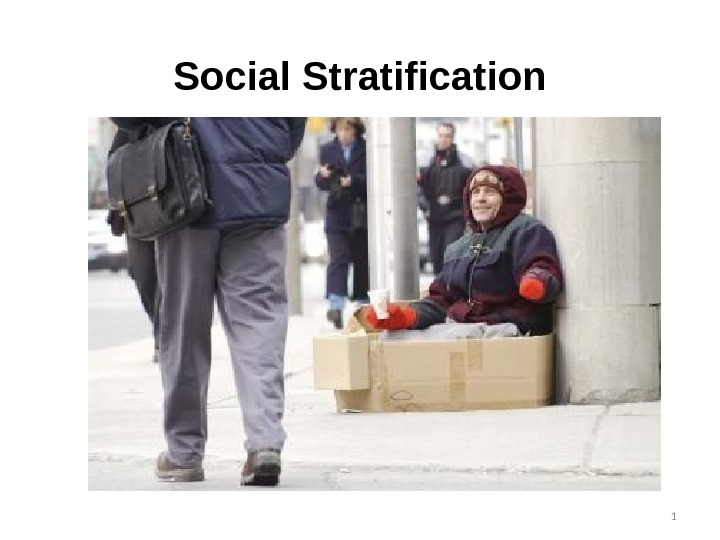
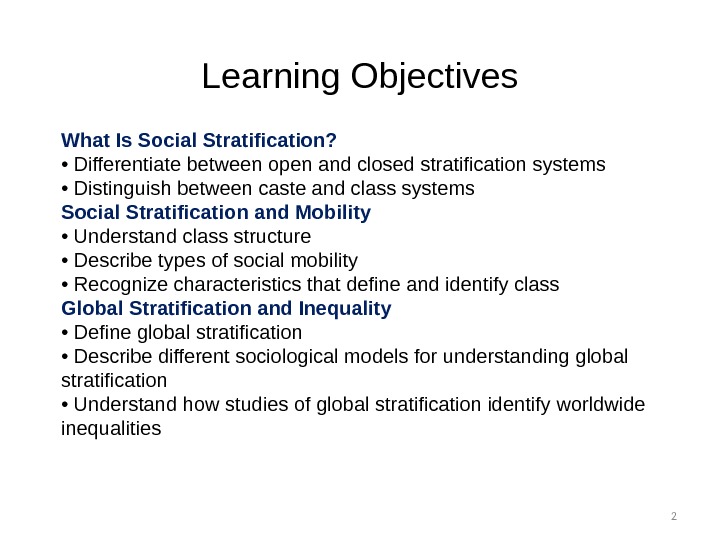
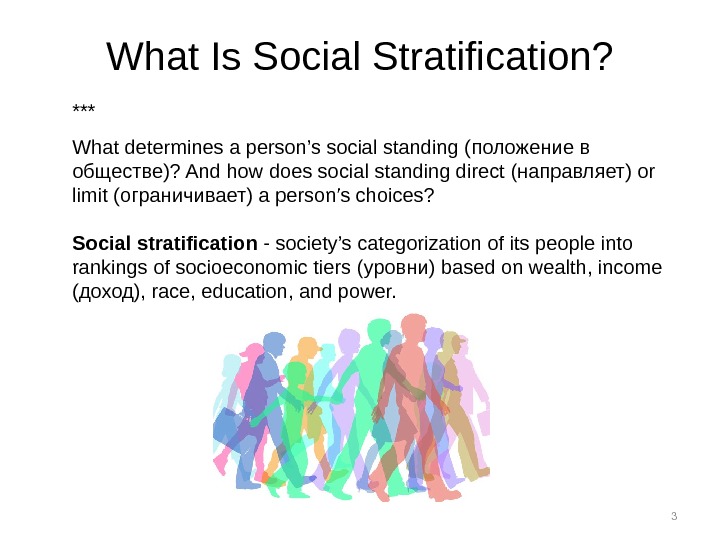

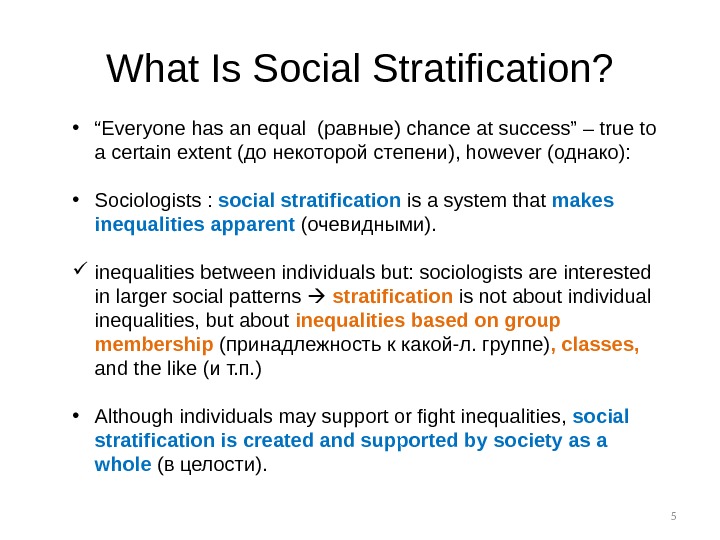
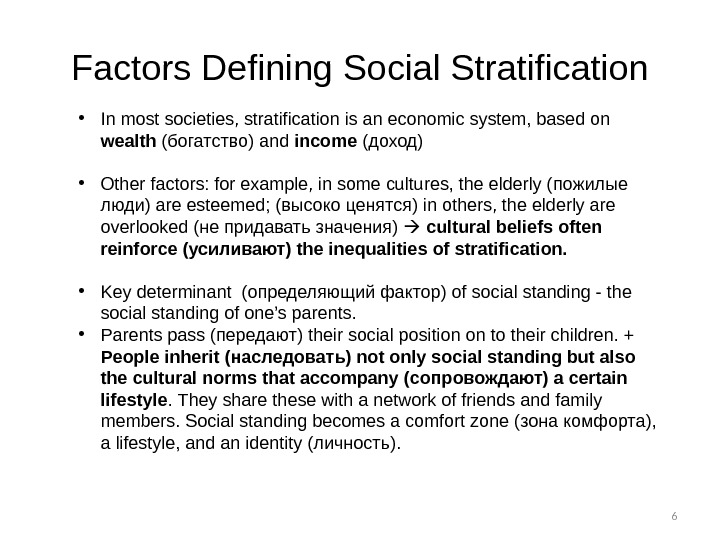
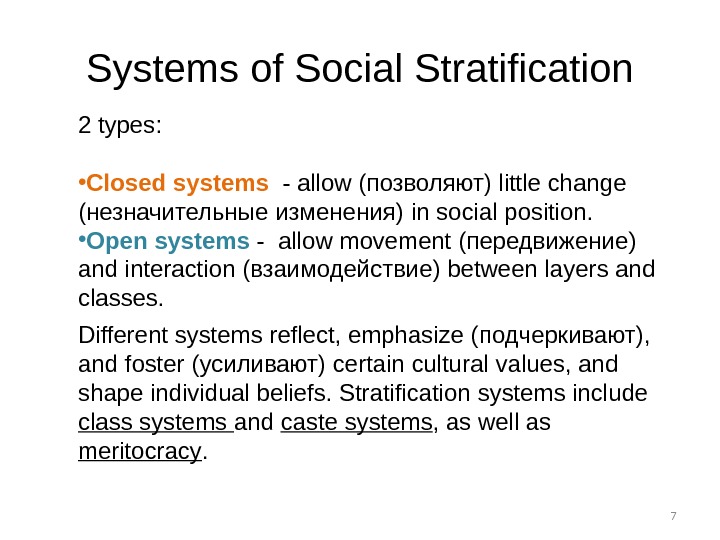
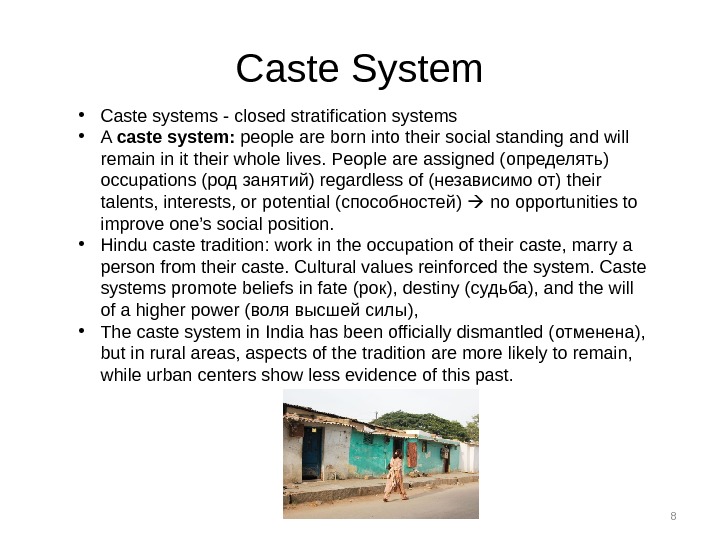
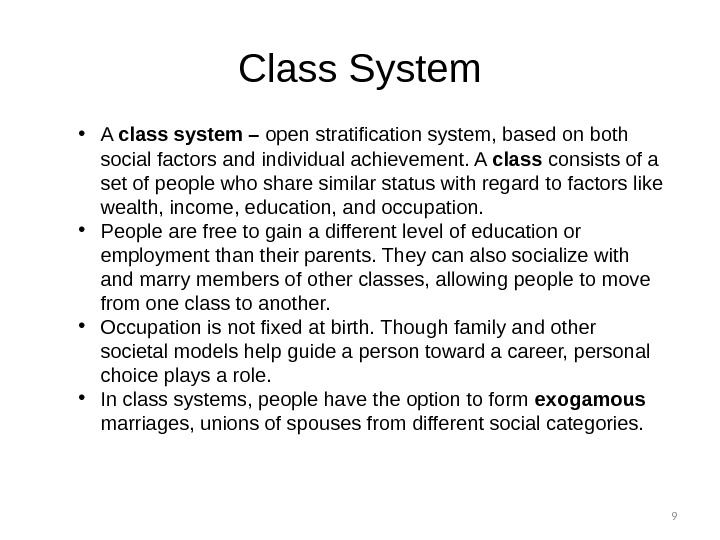


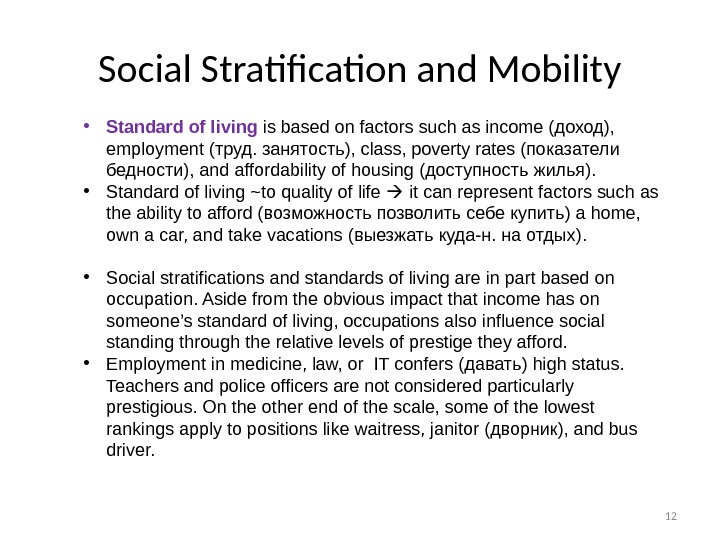

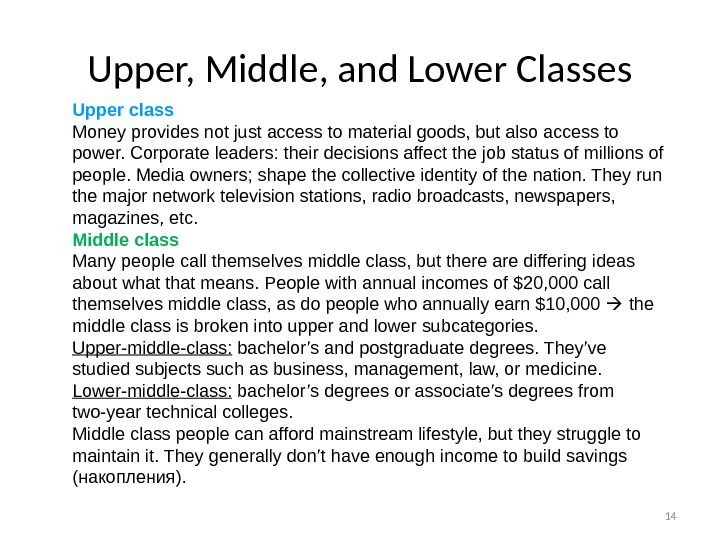

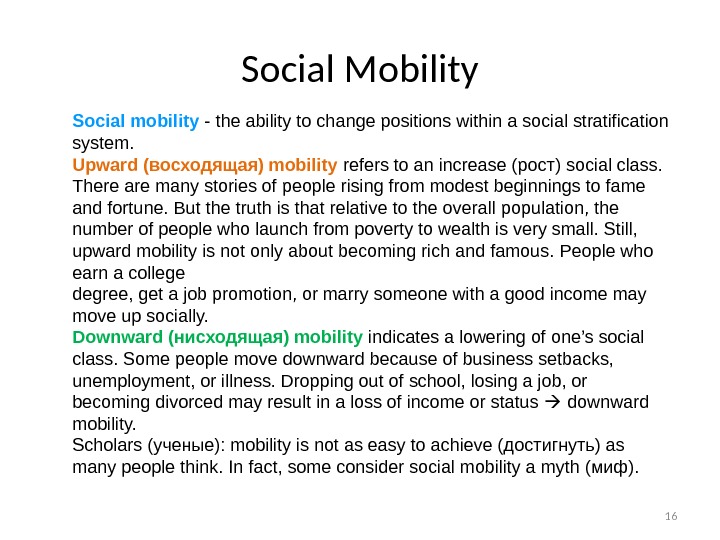


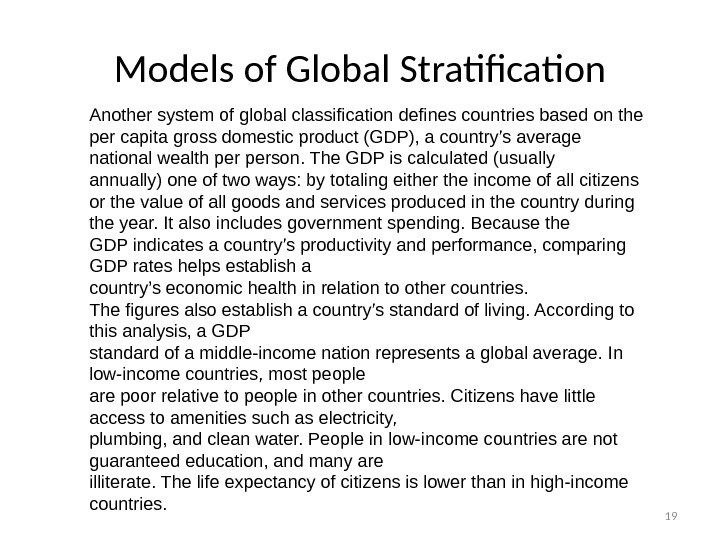
lecture_8._social_stratification.ppt
- Размер: 1.8 Mегабайта
- Количество слайдов: 19
Описание презентации Social Stratification 1 Learning Objectives 2 What по слайдам
 Social Stratification
Social Stratification
 Learning Objectives 2 What Is Social Stratification? • Differentiate between open and closed stratification systems • Distinguish between caste and class systems Social Stratification and Mobility • Understand class structure • Describe types of social mobility • Recognize characteristics that define and identify class Global Stratification and Inequality • Define global stratification • Describe different sociological models for understanding global stratification • Understand how studies of global stratification identify worldwide inequalities
Learning Objectives 2 What Is Social Stratification? • Differentiate between open and closed stratification systems • Distinguish between caste and class systems Social Stratification and Mobility • Understand class structure • Describe types of social mobility • Recognize characteristics that define and identify class Global Stratification and Inequality • Define global stratification • Describe different sociological models for understanding global stratification • Understand how studies of global stratification identify worldwide inequalities
 What Is Social Stratification? 3*** What determines a person’s social standing ( положение в обществе )? And how does social standing direct (направляет) or limit (ограничивает) a person’s choices? Social stratification — society’s categorization of its people into rankings of socioeconomic tiers (уровни) based on wealth, income (доход) , race, education, and power.
What Is Social Stratification? 3*** What determines a person’s social standing ( положение в обществе )? And how does social standing direct (направляет) or limit (ограничивает) a person’s choices? Social stratification — society’s categorization of its people into rankings of socioeconomic tiers (уровни) based on wealth, income (доход) , race, education, and power.
 4 What Is Social Stratification? • Geology: stratification” — the distinct vertical layers in rock • Society’s layers (слои общества) are made of people, and society’s resources are distributed unevenly (неравномерно) throughout ( по всем ) the layers. • The people with more resources — top layer of the social structure of stratification. People, with fewer ( меньше ) resources — the lower layers of our society.
4 What Is Social Stratification? • Geology: stratification” — the distinct vertical layers in rock • Society’s layers (слои общества) are made of people, and society’s resources are distributed unevenly (неравномерно) throughout ( по всем ) the layers. • The people with more resources — top layer of the social structure of stratification. People, with fewer ( меньше ) resources — the lower layers of our society.
 5 • “ Everyone has an equal ( равные ) chance at success” – true to a certain extent ( до некоторой степени ), however (однако) : • Sociologists : social stratification is a system that makes inequalities apparent (очевидными). inequalities between individuals but: sociologists are interested in larger social patterns stratification is not about individual inequalities, but about inequalities based on group membership (принадлежность к какой-л. группе) , classes, and the like ( и т. п. ) • Although individuals may support or fight inequalities, social stratification is created and supported by society as a whole (в целости). What Is Social Stratification?
5 • “ Everyone has an equal ( равные ) chance at success” – true to a certain extent ( до некоторой степени ), however (однако) : • Sociologists : social stratification is a system that makes inequalities apparent (очевидными). inequalities between individuals but: sociologists are interested in larger social patterns stratification is not about individual inequalities, but about inequalities based on group membership (принадлежность к какой-л. группе) , classes, and the like ( и т. п. ) • Although individuals may support or fight inequalities, social stratification is created and supported by society as a whole (в целости). What Is Social Stratification?
 6 • In most societies, stratification is an economic system, based on wealth ( богатство ) and income (доход) • Other factors: for example, in some cultures, the elderly ( пожилые люди ) are esteemed; (высоко ценятся) in others, the elderly are overlooked (не придавать значения) cultural beliefs often reinforce ( усиливают ) the inequalities of stratification. • Key determinant (определяющий фактор) of social standing — the social standing of one’s parents. • Parents pass (передают) their social position on to their children. + People inherit (наследовать) not only social standing but also the cultural norms that accompany (сопровождают) a certain lifestyle. They share these with a network of friends and family members. Social standing becomes a comfort zone ( зона комфорта ), a lifestyle, and an identity (личность). Factors Defining Social Stratification
6 • In most societies, stratification is an economic system, based on wealth ( богатство ) and income (доход) • Other factors: for example, in some cultures, the elderly ( пожилые люди ) are esteemed; (высоко ценятся) in others, the elderly are overlooked (не придавать значения) cultural beliefs often reinforce ( усиливают ) the inequalities of stratification. • Key determinant (определяющий фактор) of social standing — the social standing of one’s parents. • Parents pass (передают) their social position on to their children. + People inherit (наследовать) not only social standing but also the cultural norms that accompany (сопровождают) a certain lifestyle. They share these with a network of friends and family members. Social standing becomes a comfort zone ( зона комфорта ), a lifestyle, and an identity (личность). Factors Defining Social Stratification
 72 types: • Closed systems — allow ( позволяют ) little change (незначительные изменения) in social position. • Open systems — allow movement (передвижение) and interaction (взаимодействие) between layers and classes. Systems of Social Stratification Different systems reflect, emphasize (подчеркивают) , and foster (усиливают) certain cultural values, and shape individual beliefs. Stratification systems include class systems and caste systems , as well as meritocracy.
72 types: • Closed systems — allow ( позволяют ) little change (незначительные изменения) in social position. • Open systems — allow movement (передвижение) and interaction (взаимодействие) between layers and classes. Systems of Social Stratification Different systems reflect, emphasize (подчеркивают) , and foster (усиливают) certain cultural values, and shape individual beliefs. Stratification systems include class systems and caste systems , as well as meritocracy.
 8 • Caste systems — closed stratification systems • A caste system: people are born into their social standing and will remain in it their whole lives. People are assigned ( определять ) occupations ( род занятий ) regardless of (независимо от) their talents, interests, or potential (способностей) no opportunities to improve one’s social position. • Hindu caste tradition: work in the occupation of their caste, marry a person from their caste. Cultural values reinforced the system. Caste systems promote beliefs in fate (рок) , destiny (судьба) , and the will of a higher power (воля высшей силы) , • The caste system in India has been officially dismantled ( отменена ), but in rural areas, aspects of the tradition are more likely to remain, while urban centers show less evidence of this past. Caste System
8 • Caste systems — closed stratification systems • A caste system: people are born into their social standing and will remain in it their whole lives. People are assigned ( определять ) occupations ( род занятий ) regardless of (независимо от) their talents, interests, or potential (способностей) no opportunities to improve one’s social position. • Hindu caste tradition: work in the occupation of their caste, marry a person from their caste. Cultural values reinforced the system. Caste systems promote beliefs in fate (рок) , destiny (судьба) , and the will of a higher power (воля высшей силы) , • The caste system in India has been officially dismantled ( отменена ), but in rural areas, aspects of the tradition are more likely to remain, while urban centers show less evidence of this past. Caste System
 9 • A class system – open stratification system, based on both social factors and individual achievement. A class consists of a set of people who share similar status with regard to factors like wealth, income, education, and occupation. • People are free to gain a different level of education or employment than their parents. They can also socialize with and marry members of other classes, allowing people to move from one class to another. • Occupation is not fixed at birth. Though family and other societal models help guide a person toward a career, personal choice plays a role. • In class systems, people have the option to form exogamous marriages, unions of spouses from different social categories. Class System
9 • A class system – open stratification system, based on both social factors and individual achievement. A class consists of a set of people who share similar status with regard to factors like wealth, income, education, and occupation. • People are free to gain a different level of education or employment than their parents. They can also socialize with and marry members of other classes, allowing people to move from one class to another. • Occupation is not fixed at birth. Though family and other societal models help guide a person toward a career, personal choice plays a role. • In class systems, people have the option to form exogamous marriages, unions of spouses from different social categories. Class System
 10 The Commoner Who Could Be Queen On April 29, 2011, in London, England, Prince William, Duke (герцог) of Cambridge, married Catherine Middleton, a commoner ( простой человек ). Kate Middleton had a middle-class upbringing. Kate and William met when they were both students at the University of St. Andrews in Scotland. • Britain’s monarchy arose during the Middle Ages. Its social hierarchy placed royalty at the top and commoners on the bottom. This was a closed system , with people born into positions of nobility (знатность). • The Industrial Revolution changed Britain’s social structure. Commoners moved to cities, got jobs, and made better livings. People found new opportunities to increase their wealth and power. • Today , the government is a constitutional monarchy with the prime minister and other ministers elected to their positions, and with the royal family’s role being ceremonial. The long-ago differences between nobility and commoners have blurred ( размылись ).
10 The Commoner Who Could Be Queen On April 29, 2011, in London, England, Prince William, Duke (герцог) of Cambridge, married Catherine Middleton, a commoner ( простой человек ). Kate Middleton had a middle-class upbringing. Kate and William met when they were both students at the University of St. Andrews in Scotland. • Britain’s monarchy arose during the Middle Ages. Its social hierarchy placed royalty at the top and commoners on the bottom. This was a closed system , with people born into positions of nobility (знатность). • The Industrial Revolution changed Britain’s social structure. Commoners moved to cities, got jobs, and made better livings. People found new opportunities to increase their wealth and power. • Today , the government is a constitutional monarchy with the prime minister and other ministers elected to their positions, and with the royal family’s role being ceremonial. The long-ago differences between nobility and commoners have blurred ( размылись ).
 11 Social Stratification and Mobility • Most sociologists define social class as a grouping based on similar social factors like wealth, income, education, and occupation. • Social stratification unequal distribution of resources more money =more power or more opportunities. • Stratification can also result from physical and intellectual traits. Categories that affect social standing include family ancestry, race, ethnicity, age, and gender.
11 Social Stratification and Mobility • Most sociologists define social class as a grouping based on similar social factors like wealth, income, education, and occupation. • Social stratification unequal distribution of resources more money =more power or more opportunities. • Stratification can also result from physical and intellectual traits. Categories that affect social standing include family ancestry, race, ethnicity, age, and gender.
 12 • Standard of living is based on factors such as income ( доход ), employment (труд. занятость) , class, poverty rates (показатели бедности) , and affordability of housing (доступность жилья). • Standard of living ~to quality of life it can represent factors such as the ability to afford ( возможность позволить себе купить ) a home, own a car, and take vacations (выезжать куда-н. на отдых). Social Stratification and Mobility • Social stratifications and standards of living are in part based on occupation. Aside from the obvious impact that income has on someone’s standard of living, occupations also influence social standing through the relative levels of prestige they afford. • Employment in medicine, law, or IT confers ( давать ) high status. Teachers and police officers are not considered particularly prestigious. On the other end of the scale, some of the lowest rankings apply to positions like waitress, janitor (дворник ) , and bus driver.
12 • Standard of living is based on factors such as income ( доход ), employment (труд. занятость) , class, poverty rates (показатели бедности) , and affordability of housing (доступность жилья). • Standard of living ~to quality of life it can represent factors such as the ability to afford ( возможность позволить себе купить ) a home, own a car, and take vacations (выезжать куда-н. на отдых). Social Stratification and Mobility • Social stratifications and standards of living are in part based on occupation. Aside from the obvious impact that income has on someone’s standard of living, occupations also influence social standing through the relative levels of prestige they afford. • Employment in medicine, law, or IT confers ( давать ) high status. Teachers and police officers are not considered particularly prestigious. On the other end of the scale, some of the lowest rankings apply to positions like waitress, janitor (дворник ) , and bus driver.
 13 Social Stratification and Mobility 3 levels of class: • upper (высокий) • middle (средний) • lower (низкий) class Classification of classes by level ( по уровню ) of power: − The upper class not only have power and control over their own lives , their social status gives them power and control over others ’ lives as well. − The middle class don’t generally control other strata of society, but they have control over their own lives. − The lower class has little control over their work or lives. Within each class, there are many subcategories.
13 Social Stratification and Mobility 3 levels of class: • upper (высокий) • middle (средний) • lower (низкий) class Classification of classes by level ( по уровню ) of power: − The upper class not only have power and control over their own lives , their social status gives them power and control over others ’ lives as well. − The middle class don’t generally control other strata of society, but they have control over their own lives. − The lower class has little control over their work or lives. Within each class, there are many subcategories.
 14 Upper class Money provides not just access to material goods, but also access to power. Corporate leaders: their decisions affect the job status of millions of people. Media owners; shape the collective identity of the nation. They run the major network television stations, radio broadcasts, newspapers, magazines, etc. Middle class Many people call themselves middle class, but there are differing ideas about what that means. People with annual incomes of $20, 000 call themselves middle class, as do people who annually earn $10, 000 the middle class is broken into upper and lower subcategories. Upper-middle-class: bachelor’s and postgraduate degrees. They’ve studied subjects such as business, management, law, or medicine. Lower-middle-class: bachelor’s degrees or associate’s degrees from two-year technical colleges. Middle class people can afford mainstream lifestyle, but they struggle to maintain it. They generally don’t have enough income to build savings (накопления). Upper, Middle, and Lower Classes
14 Upper class Money provides not just access to material goods, but also access to power. Corporate leaders: their decisions affect the job status of millions of people. Media owners; shape the collective identity of the nation. They run the major network television stations, radio broadcasts, newspapers, magazines, etc. Middle class Many people call themselves middle class, but there are differing ideas about what that means. People with annual incomes of $20, 000 call themselves middle class, as do people who annually earn $10, 000 the middle class is broken into upper and lower subcategories. Upper-middle-class: bachelor’s and postgraduate degrees. They’ve studied subjects such as business, management, law, or medicine. Lower-middle-class: bachelor’s degrees or associate’s degrees from two-year technical colleges. Middle class people can afford mainstream lifestyle, but they struggle to maintain it. They generally don’t have enough income to build savings (накопления). Upper, Middle, and Lower Classes
 15 Upper, Middle, and Lower Classes The lower class/ the working class (рабочий класс) : — the working class — the working poor — the underclass • Compared to the lower middle class, lower-class people have less of an educational background and earn smaller incomes. They work jobs that require little prior skill or experience, often doing routine tasks under close supervision. • Working-class people: jobs in fields like food service: cooking, cleaning, or building. • The working poor: also unskilled, lowpaying employment. However, their jobs rarely offer benefits such as healthcare or retirement planning, and their positions are often seasonal or temporary: migrant farm workers, housecleaners, and day laborers ( временный рабочий ). • Underclass: many are unemployed ( безработный ) or underemployed (занятый неполный раб. день / месяц). Some are homeless.
15 Upper, Middle, and Lower Classes The lower class/ the working class (рабочий класс) : — the working class — the working poor — the underclass • Compared to the lower middle class, lower-class people have less of an educational background and earn smaller incomes. They work jobs that require little prior skill or experience, often doing routine tasks under close supervision. • Working-class people: jobs in fields like food service: cooking, cleaning, or building. • The working poor: also unskilled, lowpaying employment. However, their jobs rarely offer benefits such as healthcare or retirement planning, and their positions are often seasonal or temporary: migrant farm workers, housecleaners, and day laborers ( временный рабочий ). • Underclass: many are unemployed ( безработный ) or underemployed (занятый неполный раб. день / месяц). Some are homeless.
 16 Social mobility — the ability to change positions within a social stratification system. Upward ( восходящая ) mobility refers to an increase ( рост ) social class. There are many stories of people rising from modest beginnings to fame and fortune. But the truth is that relative to the overall population, the number of people who launch from poverty to wealth is very small. Still, upward mobility is not only about becoming rich and famous. People who earn a college degree, get a job promotion, or marry someone with a good income may move up socially. Downward (нисходящая) mobility indicates a lowering of one’s social class. Some people move downward because of business setbacks, unemployment, or illness. Dropping out of school, losing a job, or becoming divorced may result in a loss of income or status downward mobility. Scholars (ученые) : mobility is not as easy to achieve (достигнуть) as many people think. In fact, some consider social mobility a myth (миф). Social Mobility
16 Social mobility — the ability to change positions within a social stratification system. Upward ( восходящая ) mobility refers to an increase ( рост ) social class. There are many stories of people rising from modest beginnings to fame and fortune. But the truth is that relative to the overall population, the number of people who launch from poverty to wealth is very small. Still, upward mobility is not only about becoming rich and famous. People who earn a college degree, get a job promotion, or marry someone with a good income may move up socially. Downward (нисходящая) mobility indicates a lowering of one’s social class. Some people move downward because of business setbacks, unemployment, or illness. Dropping out of school, losing a job, or becoming divorced may result in a loss of income or status downward mobility. Scholars (ученые) : mobility is not as easy to achieve (достигнуть) as many people think. In fact, some consider social mobility a myth (миф). Social Mobility
 17 Global Stratification and Inequality • Global stratification compares the wealth, economic stability, status, and power of countries across the world. Global stratification highlights worldwide patterns of social inequality. • Sociologists studying global stratification analyze economic comparisons between nations. Income, purchasing power, and wealth are used to calculate ( высчитать ) global stratification. Global stratification also compares the quality (качество) of life that a country’s population can have.
17 Global Stratification and Inequality • Global stratification compares the wealth, economic stability, status, and power of countries across the world. Global stratification highlights worldwide patterns of social inequality. • Sociologists studying global stratification analyze economic comparisons between nations. Income, purchasing power, and wealth are used to calculate ( высчитать ) global stratification. Global stratification also compares the quality (качество) of life that a country’s population can have.
 18 Models of Global Stratification • Various models of global stratification all have one thing in common: they rank countries according to their relative economic status, or gross national product (GNP). • Traditional models, now considered • outdated, used labels to describe the stratification of the different areas of the world. Simply put: “first world, “second world, ” and “third world. ” First and second world described industrialized nations, while third world referred to “undeveloped” countries. • When researching existing historical sources, you may still encounter these terms, and even today people still refer to some nations as the “third world. ” • Another model separates countries into two groups: more developed and less developed. More developed nations have higher wealth, such as Canada, Japan, and Australia. Less developed nations have less wealth to distribute among higher populations, including many countries in central Africa, South America, and some island nations.
18 Models of Global Stratification • Various models of global stratification all have one thing in common: they rank countries according to their relative economic status, or gross national product (GNP). • Traditional models, now considered • outdated, used labels to describe the stratification of the different areas of the world. Simply put: “first world, “second world, ” and “third world. ” First and second world described industrialized nations, while third world referred to “undeveloped” countries. • When researching existing historical sources, you may still encounter these terms, and even today people still refer to some nations as the “third world. ” • Another model separates countries into two groups: more developed and less developed. More developed nations have higher wealth, such as Canada, Japan, and Australia. Less developed nations have less wealth to distribute among higher populations, including many countries in central Africa, South America, and some island nations.
 19 Another system of global classification defines countries based on the per capita gross domestic product (GDP), a country’s average national wealth person. The GDP is calculated (usually annually) one of two ways: by totaling either the income of all citizens or the value of all goods and services produced in the country during the year. It also includes government spending. Because the GDP indicates a country’s productivity and performance, comparing GDP rates helps establish a country’s economic health in relation to other countries. The figures also establish a country’s standard of living. According to this analysis, a GDP standard of a middle-income nation represents a global average. In low-income countries, most people are poor relative to people in other countries. Citizens have little access to amenities such as electricity, plumbing, and clean water. People in low-income countries are not guaranteed education, and many are illiterate. The life expectancy of citizens is lower than in high-income countries. Models of Global Stratification
19 Another system of global classification defines countries based on the per capita gross domestic product (GDP), a country’s average national wealth person. The GDP is calculated (usually annually) one of two ways: by totaling either the income of all citizens or the value of all goods and services produced in the country during the year. It also includes government spending. Because the GDP indicates a country’s productivity and performance, comparing GDP rates helps establish a country’s economic health in relation to other countries. The figures also establish a country’s standard of living. According to this analysis, a GDP standard of a middle-income nation represents a global average. In low-income countries, most people are poor relative to people in other countries. Citizens have little access to amenities such as electricity, plumbing, and clean water. People in low-income countries are not guaranteed education, and many are illiterate. The life expectancy of citizens is lower than in high-income countries. Models of Global Stratification

